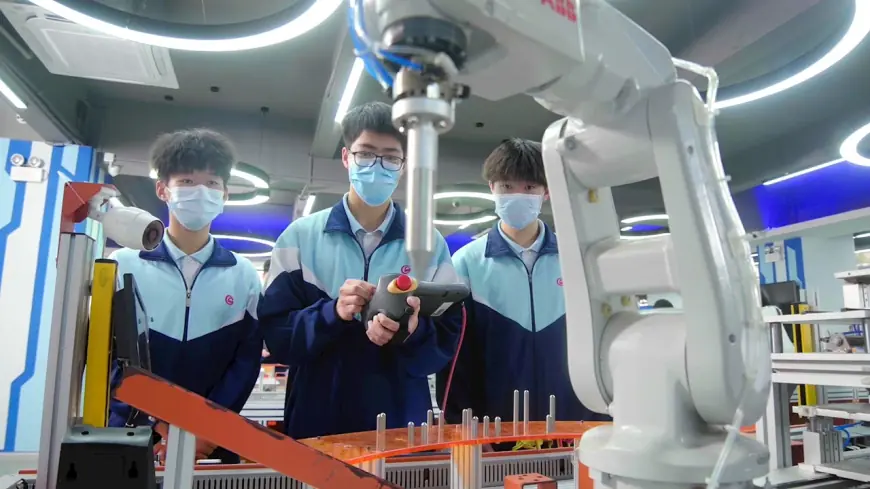How Robotics Labs Make Science and Math More Exciting for Students

In today’s world of rapid technological advancements, the integration of robotics in education is reshaping how students learn and interact with science, technology, engineering, and math subjects. A robotics lab in school provides students with hands-on learning experiences, making abstract concepts more tangible and engaging. It fosters curiosity, problem-solving skills, and collaboration, all while bringing science and math to life. Here’s how robotics labs are revolutionizing the way students perceive and excel in these critical subjects.
Bridging the Gap Between Theory and Practice
Science and math often involve complex theories and formulas that can feel disconnected from real-world applications. Robotics labs act as a bridge, translating these abstract concepts into practical scenarios. For instance, students learning about angles and trigonometry can directly apply these principles while programming a robot to navigate a specific path.
Take the example of calculating velocity or acceleration. Instead of simply solving problems on paper, students can see how adjusting a robot’s speed impacts its motion, providing them with a deeper understanding of the underlying physics. This experiential learning not only enhances comprehension but also keeps students invested in their studies.
Encouraging Active Learning
Traditional classroom settings often focus on passive learning through lectures and textbooks. Robotics labs, on the other hand, encourage active participation. When students design, build, and program robots, they are immersed in a cycle of trial, error, and improvement.
For instance, a student might be tasked with programming a robot to pick up and move objects. If the robot fails, they analyze the error, tweak the code, and test again. This hands-on approach keeps students engaged, promotes critical thinking, and builds resilience by teaching them to embrace challenges as opportunities for growth.
Promoting Collaboration and Teamwork
Robotics projects often require students to work in teams, mimicking real-world scenarios in industries like engineering and technology. In these collaborative settings, students take on roles such as programmers, designers, and project managers, learning to communicate effectively and divide responsibilities.
For example, one student may focus on coding the robot’s movements while another works on its structural design. This teamwork not only enhances their technical skills but also teaches valuable interpersonal skills that are crucial for future careers.
Making Math Fun and Relatable
For many students, math can seem daunting or monotonous when confined to formulas and equations. Robotics labs change this perception by integrating math into exciting projects.
Consider a robotics challenge where students must program a robot to move a specific distance in a set amount of time. They need to calculate the required speed, incorporating concepts like ratios and proportions. By solving these problems in a practical, engaging context, students begin to see math as a useful tool rather than an abstract subject.
Inspiring Innovation and Creativity
One of the most remarkable benefits of robotics labs is their ability to spark creativity. Unlike traditional science and math lessons that may follow rigid curricula, robotics encourages students to think outside the box.
For example, a school might host a robotics competition where students design robots to solve real-world problems, such as sorting recyclable materials or delivering small packages. These projects push students to innovate, combining scientific principles with imaginative solutions. This creative aspect makes STEM subjects more appealing and inspires students to pursue careers in these fields.
Building Technological Literacy
In an era dominated by technology, understanding how machines work is becoming increasingly important. Robotics labs equip students with essential technological skills, such as coding, engineering design, and hardware troubleshooting.
For example, students learn programming languages like Python or C++ while coding robots to perform specific tasks. They also gain insights into mechanics by assembling robot components, enhancing their understanding of how machines operate. These skills are not only valuable for academic success but also prepare students for the future job market.
Real-World Applications of Robotics in STEM
Robotics labs offer a glimpse into how science and math are applied in real-world industries. Students can explore fields like automation, artificial intelligence, and engineering, gaining inspiration for future careers.
For instance, a robotics lab may simulate how robots are used in manufacturing to assemble products or in healthcare to assist in surgeries. These examples show students the practical impact of STEM fields, motivating them to pursue further studies and careers in these areas.
Fostering a Growth Mindset
Mistakes and failures are a natural part of working with robotics. When a robot doesn’t perform as expected, students learn to identify issues, make corrections, and try again. This iterative process fosters a growth mindset, teaching students that failure is a stepping stone to success.
This mindset not only benefits students in science and math but also in their overall personal development. They learn perseverance, adaptability, and confidence—qualities that are essential for overcoming challenges in any field.
Encouraging Inclusivity in STEM
Robotics labs also play a significant role in making STEM education more inclusive. By creating engaging and accessible learning environments, they encourage participation from students who might not typically gravitate toward science and math.
For example, girls and students from underrepresented backgrounds often benefit from robotics programs that highlight diverse role models and provide supportive learning spaces. These initiatives help break stereotypes and ensure that all students feel empowered to explore STEM fields.
Conclusion
A robotics lab in school is more than just a space for building robots; it’s a dynamic learning environment that makes science and math exciting, relevant, and accessible. By bridging the gap between theory and practice, promoting collaboration, and inspiring creativity, robotics labs transform how students engage with STEM subjects. They not only enhance academic performance but also prepare students for the technological challenges of the future.
What's Your Reaction?
 Like
0
Like
0
 Dislike
0
Dislike
0
 Love
0
Love
0
 Funny
0
Funny
0
 Angry
0
Angry
0
 Sad
0
Sad
0
 Wow
0
Wow
0



















































